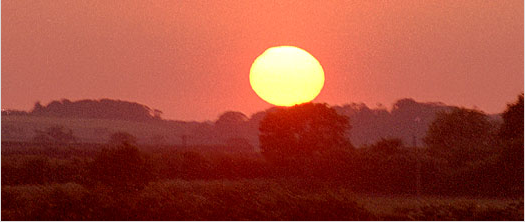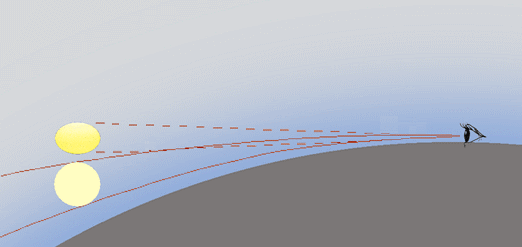Flattened Suns
Flattened Suns: Exploring the Phenomenon of Oval Shaped Suns
Have you ever witnessed a sunset where the sun appeared flattened and oval-shaped? This captivating optical illusion is known as a "flattened sun." As the name suggests, the sun's shape seems to deviate from its usual circular form and takes on an elongated appearance. In this article, we will delve into the science behind this intriguing phenomenon and uncover the factors that contribute to the creation of flattened suns.
Understanding Atmospheric Refraction and Density Gradients
To comprehend why the sun appears flattened, we must first explore the concept of atmospheric refraction. The Earth's atmosphere is not uniform in density, with variations occurring due to changes in pressure and temperature. These density gradients cause the atmosphere to act as a lens, bending light rays as they pass through it. When sunlight enters the Earth's atmosphere, it undergoes refraction, causing it to curve slightly downward.
The Effect of Atmospheric Refraction on Sun's Position
Due to atmospheric refraction, the setting sun appears higher in the sky than it actually is. This phenomenon is most noticeable near the horizon, where the curvature of the Earth plays a significant role. As the lower limb of the sun approaches the horizon, it experiences greater refraction compared to the upper limb. Consequently, the lower part of the sun is lifted more than the top, resulting in an oval shape.
Factors Influencing Flattening of the Sun
The extent of flattening observed in a sun's shape can vary depending on several factors. Here are some key considerations:
- Atmospheric Conditions: Flattening is influenced by atmospheric conditions, such as abnormal temperature gradients. Unusual variations in temperature can lead to greater distortion in the sun's shape.
- Observer Location: The degree of flattening experienced by an observer close to sea level differs from that observed from high altitudes, such as in an aircraft or from space. The higher the observer, the more pronounced the flattening effect becomes.
- Color Variations: Although the lower limb of the sun appears more flattened, the effect is not responsible for the phenomenon known as the "green flash." The green and blue components of sunlight are raised slightly more than the red, but this discrepancy is minimal.
Exploring Related Optical Phenomena
The phenomenon of flattened suns is not limited to our star alone. Other celestial bodies, such as the moon and stars, also appear higher in the sky due to atmospheric refraction. In fact, astronomical observations routinely account for this atmospheric refraction to correct for apparent positions. Lunar eclipses, in particular, exhibit striking colors like copper reds and browns. These hues are produced by sunlight refracted up to 1° around the Earth's curvature by the atmosphere, preventing the eclipse from being completely dark.
The Influence of Atmospheric Particles and Dust
The atmosphere is not only responsible for bending light rays but also affects their color. As sunlight traverses through extra miles of dense atmosphere near the horizon, it encounters particles and dust that can absorb and redden the light. This absorption and scattering contribute to the lower part of the sun appearing dimmer and more yellow compared to the top. Dustier air can exacerbate this effect, intensifying the reddening of sunlight.
Appreciating Flattened Suns: A Captivating Natural Wonder
Witnessing a flattened sun during a sunset is a captivating experience that showcases the wonders of atmospheric optics. This optical illusion, caused by atmospheric refraction and density gradients, adds a touch of mystique to our daily celestial observations. Whether you're gazing at a sunset from sea level or observing from great heights, take a moment to appreciate the subtle nuances in the sun's shape and color. The next time you find yourself marveling at a flattened sun, you'll have a deeper understanding of the science behind this enchanting phenomenon.

Summer sunset. Refraction by the atmosphere makes the sun oval. The lower part is dimmer and more yellow because its light has traveled through extra miles of dense atmosphere and possibly dustier air which has absorbed and reddened it. Photo �Les Cowley

Rays from the setting Sun (lower) are refracted by the atmosphere and make it appear higher in the sky. The lower limb is lifted more than the top, making its image oval.
Density gradients in the atmosphere cause it to act like a lens. Rays bend towards the higher density. Higher density is associated with higher pressure and lower temperature so a useful guideline for atmospheric refraction or mirages is that rays bend towards higher pressure and to cooler air.Incoming rays from the Sun curve downwards so that it appears higher in the sky than it really is. The Moon and stars and the whole sky are similarly raised and astronomical observations are routinely corrected for "atmospheric refraction".The effect is small except near to the horizon when the rays are literally bent a little around the curve of the Earth. When the lower limb of the Sun just touches the sea horizon the whole Sun has actually already set.Objects closer to the horizon are raised upwards most and the lower limb of the Sun is raised more than the top making it appear oval.The blue and green images of the sun are raised more than the red. However this effect is very small and is not the cause of the green flash.The flattening is up to about 20% for a normal atmospheric temperature profile and an observer close to sea level. It varies with atmospheric conditions especially when there are abnormal temperature gradients. From high aircraft or space the flattening is much greater. Lunar eclipses have copper reds and browns produced by sunlight refracted up to 1� around the curve of the Earth by the atmosphere. They would otherwise be almost completely dark.
Note: this article has been automatically converted from the old site and may not appear as intended. You can find the original article here.
Reference Atmospheric Optics
If you use any of the definitions, information, or data presented on Atmospheric Optics, please copy the link or reference below to properly credit us as the reference source. Thank you!
-
<a href="https://atoptics.co.uk/blog/flattened-suns/">Flattened Suns</a>
-
"Flattened Suns". Atmospheric Optics. Accessed on April 27, 2024. https://atoptics.co.uk/blog/flattened-suns/.
-
"Flattened Suns". Atmospheric Optics, https://atoptics.co.uk/blog/flattened-suns/. Accessed 27 April, 2024
-
Flattened Suns. Atmospheric Optics. Retrieved from https://atoptics.co.uk/blog/flattened-suns/.